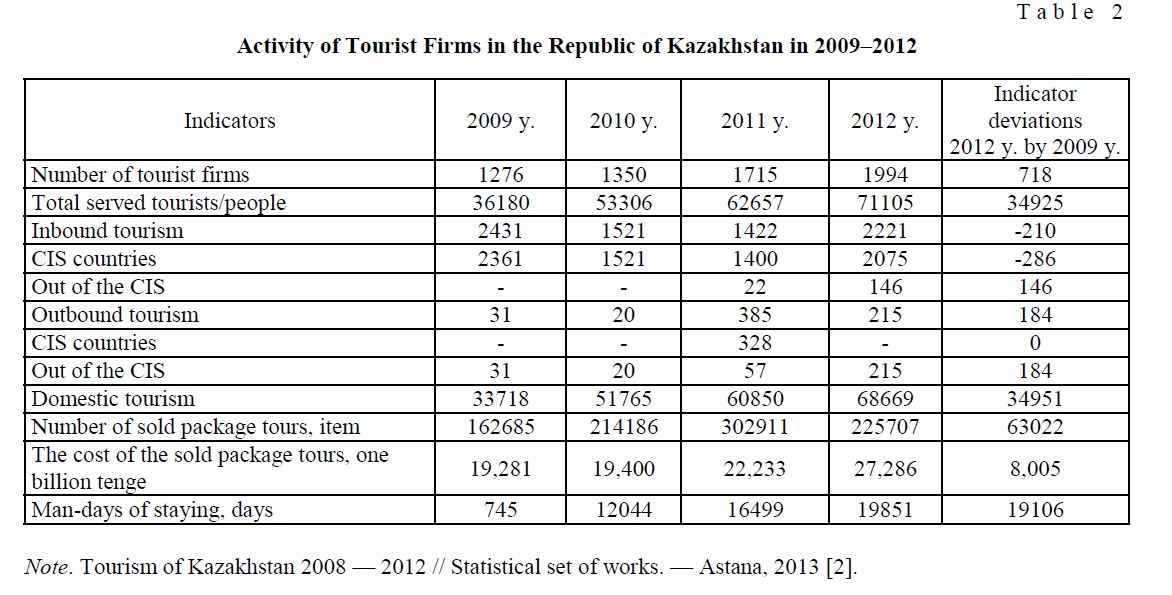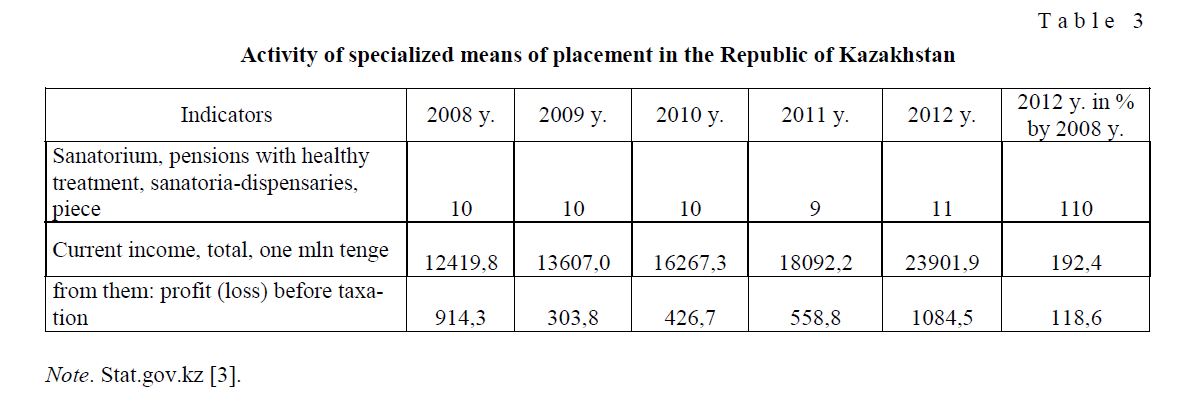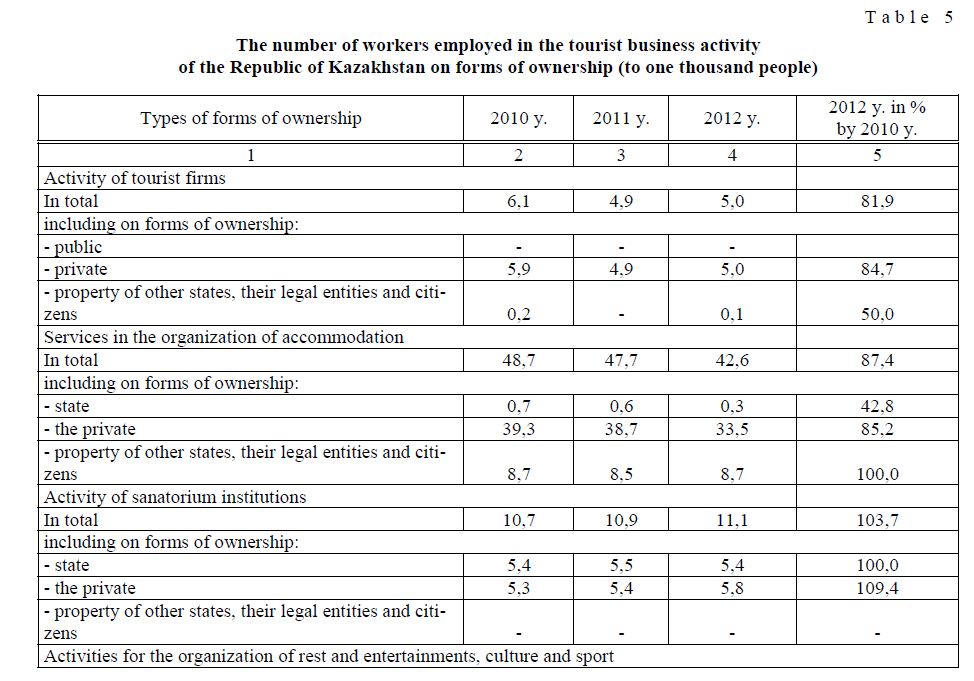The article tourist entrepreneurial activity is examined in Republic of Kazakhstan. The main purpose of tourist business activities in the development of Kazakhstan tourist industry is to create competitive tourist product in international market. Achievement of these aims requires the development of the governmental regulation system and support of tourist activity, the usage of marketing and promotion methods of tourist products. Within the framework of the tourist cluster development in the Republic of Kazakhstan there were chosen priority areas of entrepreneurial activity development in the field of tourism, such as business, ecological, cultural and cognitive tourism. Main retentive factors are educed for tourist market of Kazakhstan development.
Tourism is a priority direction in economic development in many countries. Tourism provides inflow of currency to the country, tax payments, employment, and state prestige’s enhancement on the world arena. There is no definition of the term tourism, combining criteria, which are specific for tourist industry: definitions of «tourist», «rest», «social function», «international relations», «service sector», «economy» and «knowledge». In this regard definition of tourism is specified according to mentioned criteria: «Tourism is the system of the multisectoral relations regulated by the state that covers formation of a tourist product, its provision and functioning in the period of individuals traveling, carrying out informative and social function, contributing strengthening of the international relations, economy and cultural connections».
Entrepreneur in the sphere of tourism, pursuing personal aims in profit receiving, satisfies needs of the population in rest and health recovery, which is also the responsibility of the state. It means that the goal of the state is to direct entrepreneurship in the sphere of tourism in order to achieve maximum benefit for the citizens of the country. According to mentioned above, there is the specified definition of the term «enterprise» in the sphere of tourism: «Tourist enterprise activity is the economic activity which is carried out within laws and interests of the state, individuals and the organizations, directed to the net income receiving by the means of demand meeting for recreational, professional and business, healthy, sports and religious services, based on a private property (private entrepreneurship) or on the right of economic maintaining of the state enterprise (the state venture). It is carried out on behalf of the entrepreneur, for risk and under property responsibility of the entrepreneur».
It is possible to meet a set of definitions of the concept of the tourist market in the economic literature. However, the entrepreneur, the main participant of the tourist market, is not identified in the given definitions. In this regard, we specified the definition of the market of tourist services: «The market of tourist services is a form of socioeconomic communication between entrepreneur and consumers, who are capable and have a desire to buy tourist services; it enables entrepreneurs to choose ways of production and sale of tourist services».
We suggest to consider the strategy of the development of Kazakhstan tourist product in the following directions: strategy of the sustainable development — as the most important instrument of achievement of the objectives of the territorial country development, without natural and cultural resource exhaustion and the environment harming; the strategy unique historical, cultural and natural territories development; the strategy of the selective tourism, which is based on an exact definition of the new perspective tourist markets and fast promotion of the chosen tourist destinations on these markets [1].
Nowadays the main goal of tourist business activity of tourist branch development in Kazakhstan is the creation of competitive tourist product in international markets. Implementation of these goals requires the following tasks solution: development of tourist infrastructure, development of the effective mechanism of state regulation and support of tourism, formation of attractive tourist images of the country, increasing of tourist potential, and formation of recreational zones with entertaining specialization. Achievement of these purposes requires the development of a state regulation system and support of tourist activity, use of marketing and methods of tourist product’s promotion. Now the Republic of Kazakhstan constantly takes active part in the international tourist exhibitions, such as:
- International tourist exhibition «ITB Berlin» in This is the world event in the tourism industry and the main forum for commercial communication improvement;
- Annual Mediterranean international exhibition of tourism and travel «EMITT Istanbul», Turkey;
- International exhibition in the field of tourism «FITUR MADRID», Spain;
- The largest International tourist exhibition «Market of Round-the-world Travel» in
Participation in exhibitions listed above makes good impression on the international audience; it’s the advertising method of tourist resources of the Republic of Kazakhstan. It contributes to higher level of services provision by the tour operators of Kazakhstan.
The Ministry of Foreign Affairs considers the project on abolishment of visa regime for 34 member states of the Organization of Economic Cooperation and Development as the pilot project.
Today almost all existing types of tourist business activity are presented in Kazakhstan. Within the development of a tourist cluster in the Republic of Kazakhstan there were chosen the priorities of business activity development in the area of tourism, they are business, ecological, cultural and informative tourism.
In 2012 the leading suppliers of tourist services were 1994 tourism institutions, 3 of them are public ownership and 1991 organizations are private (Table 1).
Distribution of tourist firms on forms of ownership
T a b l e 1

Note. Tourism of Kazakhstan 2008 — 2012 // Statistical set of works. — Astana, 2013 [2].
According to the Table 1 it is clear that there is a positive dynamic of the tourist firms’ number in Kazakhstan. The most of tourist firms are private.
The number of tourist firms of the joint ventures and tourist firms, which are the property of other states, their legal entities and citizens, is increasing now.
It is necessary to analyze not only the number of tourist firms, but also to take into account indicators of their activities such as the number of the served tourists, their distribution by types of tourism, the number and cost of sold package tours (Table 2).
As you can see, along with an increase of the number of travel agencies there have been increased the number of the served tourists, the number of sold package tours, the cost of sold package tours and the number of man-day staying. The cost of the sold package tours was considerably increased: from 14,2 million tenges in 2011 to 57,4 million tenge in 2012, it means there was an increase up to 4 times, taking into account the increase of sold package tours up to 1,5 times. It means that package tour’s price has considerably increased. Domestic tourism also has a tendency to increase. The importance of domestic tourism is in recreation of Kazakhstan population, development of patriotic education, education and development of young generation.
Domestic tourism allows citizens of Kazakhstan to have a rest, to use financial assets from tourism on domestic, recreational facilities, to develop internal infrastructure of the country. Effective measures in the development of domestic tourism are necessary. Development of domestic tourism contributed to decreasing of outbound tourists’ flow and intensified inbound tourism.
Activity of Tourist Firms in the Republic of Kazakhstan in 2009–2012
T a b l e 2

Note. Tourism of Kazakhstan 2008 — 2012 // Statistical set of works. — Astana, 2013 [2].
The cost of the package tour in domestic tourism is much cheaper than its cost in outbound tourism. Thus, domestic tourism serves the biggest part of the grass-roots rest, than outbound tourism, it gives an opportunity less well-oiled section of the society to have a rest.
The state has to develop measures of domestic tourism. One of the key factors influencing the development of domestic tourism is the price factor.
The state has to actualize the measures for a price decrease of tourist package tour for domestic tourism.
It can be tax preferences for legal entities, which fully or partially pay for employees’ package tours.
Today in the Republic of Kazakhstan the income of specialized locations tends to increase (Table 3).
Activity of specialized means of placement in the Republic of Kazakhstan
T a b l e 3

Note. Stat.gov.kz [3].
According to the 3rd table, over the last five years the current income of specialized means of placement has increased by 1,92 times, however its number increased only by 1 unit. Data on specially protected natural territories are shown in Table 4.
According to the table 4 it is clearly seen that the number of specially protected natural territories is increased in the Republic of Kazakhstan, but against the increase of total area and number of visitors by more than 3 times, the number of workers was reduced.
The number of workers, employed in the tourist business activity of the Republic of Kazakhstan, is shown in table 5 according to ownership.
Dynamics on specially protected natural territories
T a b l e 4

Note. Stat.gov.kz [3].
From Table 5 it is clearly seen that the number of the workers employed in tourist business activity decreased in an activity of travel agencies and objects of accommodation and there is slightly increasing in activity of health resort institutions and rest, entertainment, culture and sport institutions.
Tourist firms are represented only by private institutions, where the number of workers decreased during the period from 2010 to 2012.
The services on the accommodation provision have a small share of public sector, where the number of workers doesn't exceed 1 % of the total number of workers in the area of accommodation [4].
The number of workers employed in the tourist business activity of the Republic of Kazakhstan on forms of ownership (to one thousand people)
T a b l e 5


Note. Tourism of Kazakhstan 2008 — 2012 // Statistical set of works. — Astana, 2013 [2].
In the activity of health resort institutions the number of employees in the state enterprises is about 50 percent. The share in activities of rest and entertainments, culture and sport arrangement the number of employees in a public sector is 89 percent.
The volume of manufacturing and services in the market of tourist services is shown in Table 6.
From table 6 it is seen that the income of tourism objects tends to increase, except of cinemas, theaters, concert arrangements. Total income of tourism objects increased up to 16,5 % in 2010–2012.
T a b l e 6
The volume of manufacturing and services in the market of tourist services (million tenge)

Note. Tourism of Kazakhstan 2008–2012 // Statistical set of works. — Astana, 2013 [2].
The main «pain points» of tourism industry of Kazakhstan are the following:
- decreasing of people’s income therefore decreasing of domestic tour flow;
- the absence of efficient state policy in the sphere of tourism business;
- the lack of tourist infrastructure development;
- the low level of service and quality of tourist services;
- the lack of qualified staff of the tourist enterprises;
- non-developed transport infrastructure;
- non-developed IT communication;
- hotels don’t comply with the international standards;
- most of tourist institutions are equipped with out-of-date equipment;
- a big difference of costs of tourist services in comparison with the average income of the population;
- Kazakhstan isn't considered in the international market as the tourist Most of the foreign tourists, arriving to the republic, arrive on the business.
References
- Toksanov A.N. Bases of business activity, Astana: PRINT-S, 2007, 480
- Tourism of Kazakhstan 2008–2012: Stat. set of works, Astana,
- The official site according to the Republic of Kazakhstan, [ER]. Access mode: gov.kz.
- Yerzhanova S.K. of Karaganda University, Ser. Economy, 2011, 4 (64), p. 72–78.